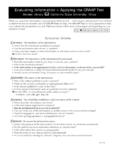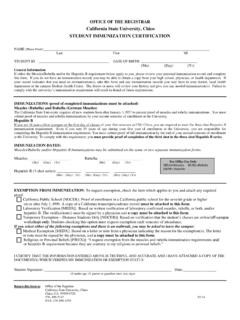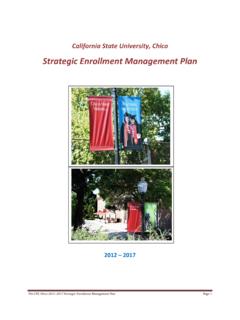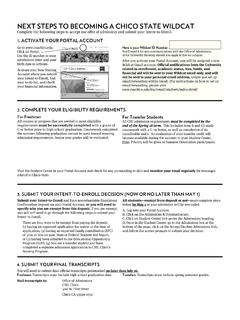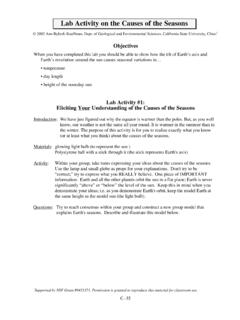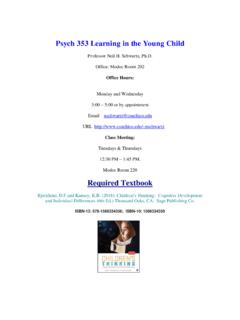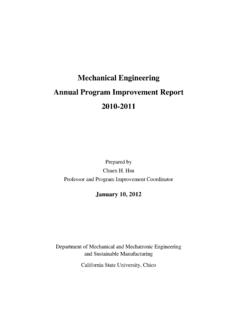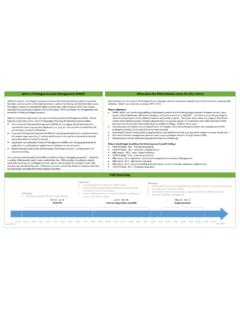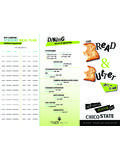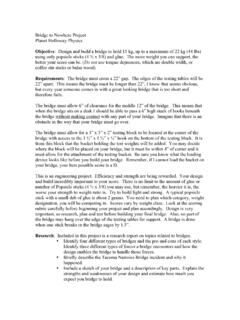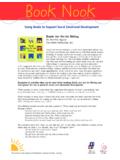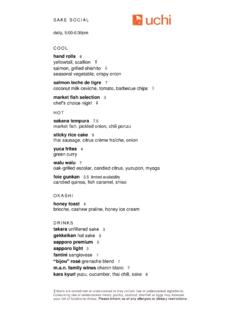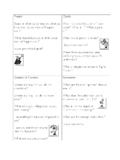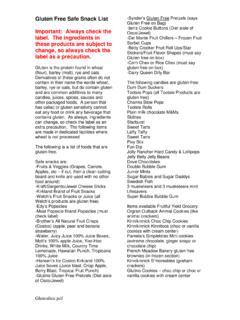Transcription of Lesson Plan Title: (Group) Mosaic Art Grade Level: …
1 Lesson plan title : ( group ) Mosaic Art Grade Level: 3rd and 4th Grades Your name: Brittany Burton, Jessica Diehl, Brianna Jones, Jessica Rouman, Dee Osburn Objectives: 1. (Domain 1: Artistic perception): Students will learn the basic concepts of the elements of art especially texture by using the technique of Mosaic art. 2. (Domain 2: Creative Expression): Students will learn the basic technique of Mosaic in this decorative art project using ceramic glass pieces to create a personalized picture frame. 3. (Domain 3: Historical and Cultural Context of the Visual Arts): Students will learn historical and cultural background of Mosaic art dating back to the 3rd millennium BC.
2 4. (Domain 4: Aesthetic Valuing): Students will learn to understand and discuss the technique and texture of Mosaic art. 5. (Domain 5: Connections, Relationships, and Application): Students will learn to use this technique to connect and learn about other areas of the curriculum such as Ancient Egypt and Greece, and to illustrate stories in Language Arts. Students Materials: 1. Table Cover 2. Popsicle sticks 3. Ceramic plate shards 4. Elmers glue 5. Grout Teacher Materials: 1. Power point presentation on Mosaic styles and techniques 2.
3 Real life examples of Mosaic art 3. Hammer 4. Ceramic tiles/plates Vocabulary: 1. Mosaic 2. Mesopotamia 3. Gaudi 4. ciottoli 5. Trencadis 6. Art Nouveau 7. Grout Procedures: : Begin Lesson with brief discussion and power point presentation on historical and cultural background of Mosaic Art: Mosaic is the art of creating images with the use of small pieces of colored glass, stone, or other materials. It may be used as a technique of decorative art, an aspect of interior decoration, or of cultural and spiritual significance as in a cathedral.
4 They usually are used to produce a certain pattern or picture. The history in Mosaic has a foundation in the early cultures of Ancient Mesopotamia, Egypt, Greece, Rome and Byzantine. Each of these empires developed a unique and distinctive style to their mosaics. Experts state how it is hard to tell exactly when Mosaic artwork started, but they have found pieces dating from 4,000 years ago. Some of the earliest known examples of mosaics made of different materials were found at a temple building in Ubaid, Mesopotamia, and are dated to the second half of 3rd millennium BC.
5 They consist of pieces of colored stones, shells and ivory. They also used what is called Terra Cotta cones. They were put in the walls and columns of buildings adding designs to the pieces. Evidence shows of the first glazed tiles dating from around 1500 BC. Egyptians were the first to find out how to use fused glass. They decorated ships, buildings, palaces, and temples. With Greek mosaics they were crafted out of worn down ciottoli (or pebbles). With time, they learned how to arrange the pebbles in a picture so that shading and designs were created to make the pictures more realistic.
6 They also used strips of lead to define lines in the pictures. The Art Nouveau movement embraced the revival of Mosaic art. Antoni Gaudi, a Spanish architect in Barcelona, created unusual new architectural forms covered with mosaics. He used tiles and other found objects to cover buildings and other surfaces. This technique is known as trencadis and was a revolutionary idea in art and architecture. It redefined the traditional methods of Mosaic art. In the 1930 s, French artist Raymond Eduardo Isidore began the Mosaic work that would eventually cover every surface of his house, both inside and out, using every shard, fragment, and piece of usable material he could find.
7 2. Show real life examples of Mosaic artwork. 3. Discuss purpose of activity in conjunction with characteristics of artistic development for this age group . Students in the 3rd and 4th Grade generally exhibit the characteristics of artistic development of Realism. Students in this stage of artistic development are highly interested in creating art that is much more realistic than their previous artwork. They begin to acknowledge in their drawings realities about the world around them such as drawing the sky to meet the horizon and overlapping images to depict spatial effects.
8 More care is given to proportion of the figures in their drawings with less exaggeration. It is helpful for students of this age to be given examples of still life models such as flowers to help them recreate the image. This could be a popular choice for a Mosaic project. Students at this stage of artistic development are also highly interested in color and representing true to life images, but are capable of using color in other ways to express their feelings. Students at this stage are susceptible to frustration, which could lead them to become disinterested in doing art.
9 To help students, close supervision and guidance that will allow them to use color and shape to create art that is satisfactorily realistic to them. Discussions about shape, color, and proportion should take place between the student and the teacher and the student should be allowed adequate freedom to develop their own artistic style while providing the instruction needed for students to gain the skill needed to create realistic pieces of art. As with all stages of development, several stages may overlap exhibiting characteristics from each stage.
10 4. Demonstration 5. Glue popsicle sticks together to form picture frame. 6. Break ceramic pieces as needed 7. Glue ceramic pieces on picture frame. 8. Optional grout. 9. Write name on back of project. 10. Display artwork. Closure: Have students share about their Mosaic piece. Visual Procedures: Step 1 Step 2 Step 3 Step 4 Glue popsicle sticks Break ceramic Glue Ceramic Grout (optional) Assessments, Suggestions and/or Comments: Rubric: Category A: Highly Competent B: Competent C: Emerging Competence D: Competence not Evident Popsicle Frame Mosaic style Overall quality Suggestions & Comments: This is a great project for students of all ages.
